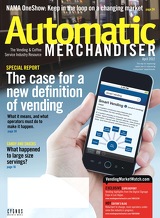Automatic Merchandiser serves the business management, marketing, technology and product information needs of its readers including vending operators, coffee service operators, product brokers, and product and equipment distributors in print.
Page 39 of 47
C O VE R ST O R Y :
S M A R T VE N D I N G
And we couldn't keep them stocked.
The point is smart vending will open doors that we can't even imagine today. Not only can we sell higher priced items, sell more items per person and have more frequent visits, but it opens the door to sell all kinds of things that can help improve operator profi tability. Operators who embrace smart
vending will realize the opportuni- ties to increase sales far exceed the opportunities to save costs. But it does take a bit of a leap. To justify investments in smart vending, operators will inevitably try to do a return on investment calculation. That has inherent problems because the operator is trying to justify a future cost with historical sales. The two don't match up. There is no accurate way to do the calcula- tion. Any calculation will require unfounded assumptions. But astute operators who embrace smart vend- ing technology will reap gains that simply cannot be calculated today. Our industry is at the point
where it must change, and become much less reliant on the dollar bill. Moreover, we must broaden our use of technology to improve the user experience, not just try to save on operating costs. Without change, things can spi-
ral downward rapidly, just like the movie rental stores, fi lm process- ing stores, or pay phones. As an industry, we can do better. And we will do better. Changes will happen fast, but operators will need to be committed. Are you ready?
ABOUT THE AUTHOR Paresh Patel, Ph.D.,
M.B.A., is owner and president of Cour- tesy Vending LLC in Portland, Ore.
38
Cashless technology removes the barriers associated with cash. Cash and cashless: compare the costs
Most operators lament the fact that cashless transactions incur a processing fee. This fee is usually in the neighborhood of 5 percent to 6 percent, and it is often one of the main barriers operators face in deploying cashless across a wider base of machines. The concern is valid because 5 percent is quite high in our industry where every penny matters.
Operators typically argue that with cash transactions, there are no fees and it is hard to justify the fees paid on cashless. True, there are no "fees" at the machine for the cash transactions. However, operators fail to consider the true cost of cash transactions.
There is a real cost to cash transac- tions once the operator takes into consideration all of the follow- ing: cost of money room person- nel, money room equipment and service, armored car transport, bank charges to deposit the cash, bank charges to buy rolled coin to replenish vending machines,
repair and service cost of bill acceptors and coin mechanisms, internal theft, vandalism, service calls related to bill, coin, or change problems (probably over 60 percent of calls are related to cash in one way or another), downtime due to cash problems, lost sales from customers unable to pay with cash, supervisory time to reconcile cash, and more.
Taking all this into consideration, most operators will fi nd that the cost of processing cash transac- tions actually exceeds 5 percent. While not all of the costs listed above can be eliminated, certainly the costs start declining as cash- less transactions increase.
In short, just because there isn't a "fee" associated with cash transactions does not mean there is no cost to it. Quite the con- trary, even with the fees for cash- less, most operators will begin to experience some overall cost savings as their cashless transac- tion volume increases.
Automatic Merchandiser VendingMarketWatch.com April 2012
